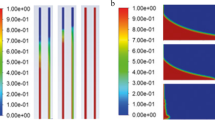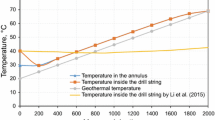Abstract
The basis of designing gasified drilling is to understand the behavior of gas/liquid two-phase flow in the wellbore. The equations of mass and momentum conservation and equation of fluid flow in porous media were used to establish a dynamic model to predict wellbore pressure according to the study results of Ansari and Beggs-Brill on gas-liquid two-phase flow. The dynamic model was solved by the finite difference approach combined with the mechanistic steady state model. The mechanistic dynamic model was numerically implemented into a FORTRAN 90 computer program and could simulate the coupled flow of fluid in wellbore and reservoir. The dynamic model revealed the effects of wellhead back pressure and injection rate of gas/liquid on bottomhole pressure. The model was validated against full-scale experimental data, and its 5.0% of average relative error could satisfy the accuracy requirements in engineering design.
Similar content being viewed by others
Abbreviations
- ρ:
-
Density, kg/m3
- μ:
-
Viscosity, Pa·s
- θ:
-
Deviation angle, degrees
- σ:
-
Interfacial tension, N/m
- ε:
-
Absolute roughness of pipe or hole, m
- dp/dz:
-
Pressure gradient, Pa/m
- D :
-
Equivalent hydraulic diameter, m
- f :
-
Friction factor, dimensionless
- g :
-
Gravity acceleration, m/s2
- h :
-
Reservoir thickness, m
- H 1 :
-
Liquid holdup, dimensionless
- L :
-
Length, m
- p :
-
Pressure, Pa
- p r :
-
Average reservoir pressure, Pa
- p bh :
-
Bottom-hole pressure, Pa
- q omax :
-
Absolute open flow rate, m3/s
- q o :
-
Oil flow rate, m3/s
- Re :
-
Reynolds number, dimensionless
- u :
-
Velocity, m/s
- l:
-
Liquid
- g:
-
Gas
- m:
-
Mixture
- sg:
-
Superficial gas
- sl:
-
Superficial liquid
- ∞:
-
Discrete bubble
- acc:
-
Acceleration
- ls:
-
Liquid slug
- tb:
-
Taylor bubble
- su:
-
Slug unit
- d:
-
Developing
- el:
-
Elevation
- f:
-
Friction
References
Ansari A. M., Sylvester N. D., Sarica C.et al. (1994) A comprehensive mechanistic model for upward two-phase flow in wellbores.SPE Production & Facilities, (5), 143–152
Beggs H. D. and Brill J. P. (1973) A study of two phase flow in inclined pipes.JPT, (5), 607–617
Bijleveld A. F., Koper M. and Saponja J. (1998) Development and application of an underbalanced drilling simulator. IADC/SPE Drilling Conference held in Dallas, Texas, 3–6 March, 1998 (SPE paper 39303)
Chen N. H. (1979) An explicit equation for friction factor in pipe.Industrial & Engineering Chemistry Fundamentals, 18(3), 296
Guo B. Y., Hareland G. and Rajtar J. (1993) Computer simulation predicts unfavorable mud rate for aerated mud drilling.SPE Drilling & Completion, 11(2), 61–66 (SPE paper 26892)
Lage A. C. V. M., Fjelde K. K. and Time R. W. (2000) Underbalanced drilling dynamics: Two-phase flow modeling and experiments. IADC/SPE Asia pacific Drilling Technology Conference held in Kuala Lumpur, Malaysia, 11–13 September, 2000 (SPE paper 62743)
Liu G. F. and Medley G. H. Jr. (1996) Foam computer model helps in analysis of underbalanced drilling.Oil and Gas Journal, 94(27), 114–119
Lu J. F. and Guan Z. (2004)Numerical Solution to Partial Differential Equations. Beijing: Tsinghua University Press (in Chinese)
Perez-Tellez C., Smith J. R. and Edwards J. K. (2002) A new comprehensive mechanistic model for underbalanced drilling improves wellbore pressure predictions. SPE International Petroleum Conference and Exhibition held in Mexico, Villahermosa, Mexico, 10–12 February, 2002 (SPE paper 74426)
Ping L. Q., Wang Z. M. and Wei J. G. (2007) Application of pressure drop model of gas/liquid two-phase flow in underbalanced drilling.Natural Gas Industry, 27(4), 72–75 (in Chinese)
Sharma Y., Kamp A., Yonezawa T.,et al. (2000) Simulating aerated drilling. SPE Asia Pacific Conference on Integrated Modeling for Asset Management held in Yokohama, Japan, 25–26 April, 2000 (SPE paper 59424)
Tian S. F., Medley G. H. and Stone C. R. (2000) Optimizing circulation while drilling underbalanced.World Oil, (6), 48–55
Zhou K. J. (1998) Analysis of the multiphase flow circulating system of underbalanced pressure drilling.Natural Gas Industry, 18(5), 44–47 (in Chinese)
Author information
Authors and Affiliations
Additional information
Wang Zhiming was born in 1964 and received his PhD degree from China University of Petroleum in 1993. Now as a professor, he works in the China University of Petroleum (Beijing), with his research interests in fluid flow mechanics and well completion engineering. E-mail: wangzm@cup.edu.cn
Rights and permissions
About this article
Cite this article
Zhiming, W., Liqiu, P. & Ke, Z. Prediction of dynamic wellbore pressure in gasified fluid drilling. Pet. Sci. 4, 66–73 (2007). https://doi.org/10.1007/BF03187458
Received:
Issue Date:
DOI: https://doi.org/10.1007/BF03187458




